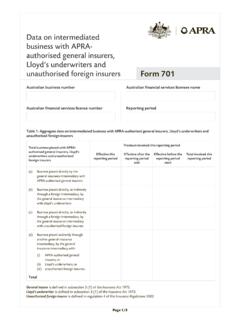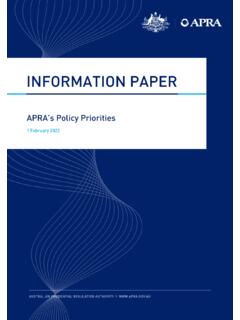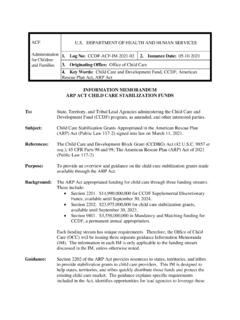Transcription of REVITALIZATION & PLACEMAKING FAQ
1 The REVITALIZATION and PLACEMAKING (RAP) program is an incentive program that will deploy $100 million in American Rescue Plan funding to address the COVID-19 impacts in Michigan communities by providing access to real estate and place-based infrastructure development gap financing in the form of grants of up to $5 million per project for real estate rehabilitation and development, grants of up to $1 million per project for public space improvements, and grants of up to $20 million to local or regional partners who develop a coordinated subgrant information and program guidelines can be found at If you re looking for a specific topic, please click ctrl and F keys to search this document and locate previously answered questions. Please note that any supporting materials including letters of support that are not uploaded as part of the application submission will not be reviewed as part of the application evaluation NOTE: Now that the RAP grant applications are live, all programmatic and project questions should be directed to In order to provide transparency and consistency in answers, questions will be restated without names or project-specific information and answered in this FAQ document that is updated weekly.
2 The last day for submitting REVITALIZATION and PLACEMAKING questions will be Thursday May 26, 2022. Applications are due on June 3, 2022. IMPORTANT CORRECTIONS: The answer to question No. 2 has been corrected, based upon updated federal compliance and reporting guidance. It is now understood that because the RAP program includes total expected capital expenditures of over $10 million, it will be necessary to provide labor reporting for all capital expenditures supported by the program as outlined for infrastructure projects on pages 26 and 27 of that guidance. Each of the individual RAP project awardees and sub-grant awardees will be responsible for Davis-Bacon Act requirements and recipients will need to provide documentation of wages and labor standards regardless of the size of their RAP award.
3 The answer to question No. 3 has been revised based on updated federal & PLACEMAKING FAQEDITOR'S NOTE: January 18, 2022, updates: Four new questions and answers have been added to page 13. The answer to question 38 has been updated to reflect new federal guidance made available on January 14, 2022. Changes in paragraph 3 have been bolded for easy reference. January 24, 2022, updates: Four new questions and answers have been added to page 14. January 31, 2022, updates: Two new questions and answers have been added to page 7, 2022, updates: The recently released Final Rule and Final Rule Overview provide guidance that expands the set of households and communities that are presumed to be impacted and disproportionately impacted by the pandemic.
4 Language has been adjusted throughout this document to reflect the new guidance. Changes are shown in bold for easy reference. An additional question and answer has been added to page 14, 2022, updates: Five new questions and answers have been added to page 22, 2022, updates: Eight new questions and answers have been added to page 28, 2022, updates: Six new questions and answers have been added to page 7, 2022, updates: On February 28, 2022, Treasury released updated compliance and reporting guidance for the State and Local Federal Relief Fund (SLFRF) programs which responds to the updated SLFRF final rule. The new guidance has resulted in necessary changes to the expenditure categories for the RAP program, as the expenditure categories initially anticipated to best fit the RAP program have been altered.
5 Under the new guidance, Aid to Travel, Tourism, and Hospitality is now numbered Aid to Travel, Tourism, and Hospitality. We ve determined Social Determinants of Health Other (now Other Economic Impact ) is no longer appropriate under the new compliance and reporting guidance. Because of the increased flexibility under the SLFRF final rule, we ve determined two new expenditure categories are now appropriate for the RAP program: Strong Healthy Communities: Neighborhood Features that Promote Health and Safety, and Rehabilitation of Commercial Properties or Other Improvements. Information on the RAP website will be updated as soon as possible to reflect these expenditure category changes, and the draft application will also be updated.
6 The compliance and reporting guidance also explicitly detailed reporting for capital expenditures and provided a list of capital expenditure types, which will be of interest to applicants. Four new questions and answers have been added to page 20. March 14, 2022, updates: Please note that a there is an updated draft RAP application and an updated program schedule. An updated draft RAP application has been posted to It was necessary to update the application to align with changes in the compliance and reporting guidance for the State and Local Federal Relief Fund (SLFRF) and SLFRF final rule. Other modifications were also made to the document based on stakeholder feedback and all modified sections are highlighted for easy reference. Five new questions and answers have been added to page 21.
7 March 21, 2022, updates: Two new questions and answers have been added to page 28, 2022, updates: An additional question and answer has been added to page 4, 2022, updates: Four additional questions and answers have been added to page 11, 2022, updates: Six additional questions and answers have been added to page 19, 2022, updates: Twenty-seven additional questions and answers have been added and begin on page 25, 2022, updates: Ten additional questions and answers have been added and begin on page 2, 2022, updates: Eight additional questions and answers have been added to page 9, 2022, updates: Nine additional questions and answers have been added to page 16, 2022, updates: 16 additional questions and answers have been added to page 31, 2022, updates: 20 additional questions and answers have been added to page & PLACEMAKING FAQ2 REVITALIZATION & PLACEMAKING FAQ1.
8 How will MEDC be evaluating applications? Applications will be evaluated and scored on a variety of factors, including but not limited to: Ability of project to be completed within the American Rescue Plan Act time limits, which require the funds to be obligated by December 31, 2024, and expended by December 31, 2026. Local Support and Match: All submissions must include a letter of support from the local or regional economic development organization and/or municipality. The most competitive proposals will also include a financial contribution from the local unit of government. Location: Preference will be given to projects located in federal qualified census tracts (QCT) and to projects located in traditional downtowns or commercial corridors. COVID Impact: Applicants must address how the proposal is responsive to the negative public health and/or economic impacts of the COVID-19 pandemic and complies with all ARPA requirements and guidance as described in the Final Rule and Final Rule Overview.
9 Capacity: The applicant, consultant or individual member of the development team must have experience implementing a project of a similar scope. Long-term Impacts: Competitive applicants will be able to articulate how the proposal will have a long-term impact in the community, including addressing how it will enable growth in population and tax revenue. Projects that include housing must include units that are priced to be attainable to the local workforce, including households with less than 120 percent of the area median income. Financial Viability: Demonstrate long-term financial viability of the project and financial need for the incentive. Local and Regional Impact Considerations: Project should demonstrate how it supports the vision and goals stated in the local master plan, downtown plan, capital improvements plan and/or economic development strategy.
10 Project should also demonstrate the readiness of Do Davis-Bacon Act wage requirements apply to RAP projects? Based on updated Federal Compliance and Reporting Guidance, it is now understood that because the RAP program includes total expected capital expenditures of over $10 million, it will be necessary to provide labor reporting for all capital expenditures supported by the program as outlined for infrastructure projects on pages 26 and 27 of that guidance. Each of the individual RAP project awardees and sub-grant awardees will be responsible for Davis-Bacon Act requirements and recipients will need to provide documentation of wages and labor standards regardless of the size of their RAP What is the significance of the federal qualified census tracts?







